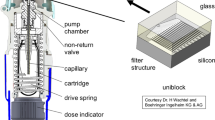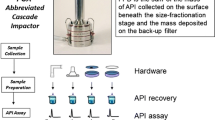Abstract
The purpose of this article is to review the suitability of the analytical and statistical techniques that have thus far been developed to assess the dissolution behavior of particles in the respirable aerodynamic size range, as generated by orally inhaled products (OIPs) such as metered-dose inhalers and dry powder inhalers. The review encompasses all analytical techniques publicized to date, namely, those using paddle-over-disk USP 2 dissolution apparatus, flow-through cell dissolution apparatus, and diffusion cell apparatus. The available techniques may have research value for both industry and academia, especially when developing modified-release formulations. The choice of a method should be guided by the question(s) that the research strives to answer, as well as by the strengths and weaknesses of the available techniques. There is still insufficient knowledge, however, for translating the dissolution data into statements about quality, performance, safety, or efficacy of OIPs in general. Any attempts to standardize a dissolution method for compendial inclusion or compendial use would therefore be premature. This review reinforces and expands on the 2008 stimulus article of the USP Inhalation Ad Hoc Advisory Panel, which “could not find compelling evidence suggesting that such dissolution testing is kinetically and/or clinically crucial for currently approved inhalation drug products.”














Similar content being viewed by others
Abbreviations
- ACI:
-
Andersen Cascade Impactor
- API:
-
active pharmaceutical ingredient
- APSD:
-
aerodynamic particle size distribution
- BDP:
-
beclomethasone dipropionate
- COPD:
-
chronic obstructive pulmonary disease
- DDW:
-
double distilled water
- DPI:
-
dry powder inhaler
- DPPC:
-
dipalmitoylphosphatidylcholine
- ELF:
-
epithelial lung fluid
- FP:
-
fluticasone propionate
- ICS:
-
inhaled corticosteroid
- IPAC-RS:
-
International Pharmaceutical Aerosol Consortium on Regulation and Science
- IVIVC:
-
in vivo in vitro correlation
- LABA:
-
long-acting beta agonist
- MDI:
-
metered dose inhaler
- NGI:
-
Next Generation Pharmaceutical Impactor
- OIP:
-
orally inhaled product
- PBS:
-
phosphate-buffered saline
- PC:
-
phosphatidylcholine
- PD:
-
pharmacodynamic
- PK:
-
pharmacokinetic
- PVDF:
-
polyvinylidene difluoride
- SLF:
-
simulated lung fluid
- USP:
-
US Pharmacopeia
REFERENCES
US FDA CDER. Guidance for Industry: Dissolution testing of immediate release solid oral dosage forms. http://www.fda.gov/downloads/Drugs/GuidanceComplianceRegulatoryInformation/Guidances/ucm070237.pdf (1997). Accessed 4 Oct 2011.
US FDA CDER. Guidance for Industry: Extended release oral dosage forms: Development, Evaluation and Application of In Vitro/In Vivo Correlations. http://www.fda.gov/downloads/Drugs/GuidanceComplianceRegulatoryInformation/Guidances/ucm070239.pdf (1997). Accessed 4 Oct 2011.
US FDA CDER. Draft guidance: metered dose inhaler (MDI) and dry powder inhaler (DPI) drug products chemistry, manufacturing and controls documentation. http://www.fda.gov/downloads/Drugs/GuidanceComplianceRegulatoryInformation/Guidances/ucm070573.pdf (1998). Accessed 4 Oct 2011.
US FDA CDER. Nasal spray and inhalation solution, suspension, and spray drug products chemistry, manufacturing, and controls documentation. http://www.fda.gov/downloads/Drugs/GuidanceComplianceRegulatoryInformation/Guidances/ucm070575.pdf (2002). Accessed 4 Oct 2011.
Joint EMA and Health Canada Guidance. Pharmaceutical quality of inhalation and nasal products. http://www.hc-sc.gc.ca/dhp-mps/prodpharma/applic-demande/guide-ld/chem/inhalationnas-eng.php (2006); EMEA/CHMP/QWP/49313/2005 Corr http://www.emea.europa.eu/pdfs/human/qwp/4931305en.pdf (2006). Accessed 3 Oct 2011.
US FDA CDRH. Reviewer guidance for nebulizers, metered dose inhalers, spacers and actuators. http://www.fda.gov/MedicalDevices/DeviceRegulationandGuidance/GuidanceDocuments/ucm081282.htm (1993). Accessed 4 Oct 2011.
US FDA CDER. Guidance for the in vitro portion of bioequivalence requirements for metaproterenol sulfate and albuterol inhalation aerosols (metered dose inhalers). http://www.fda.gov/downloads/Drugs/GuidanceComplianceRegulatoryInformation/Guidances/ucm070242.pdf (1989). Accessed 4 Oct 2011.
Lee SL, Adams WP, Li BV, Conner DP, Chowdhury BA, Yu LX. In vitro considerations to support bioequivalence of locally acting drugs in dry powder inhalers for lung diseases. AAPS J. 2009;11:414–23.
EMA. Guideline on the requirements for clinical documentation for orally inhaled products (OIP) including the requirements for demonstration of therapeutic equivalence between two inhaled products for use in the treatment of asthma and chronic obstructive pulmonary disease (COPD) in adults and for treatment of asthma in children and adolescents. http://www.ema.europa.eu/docs/en_GB/document_library/Scientific_guideline/2009/09/WC500003504.pdf (2009). Accessed 4 Oct 2011.
Health Canada Draft Guidance Document: submission requirements for subsequent market entry inhaled corticosteroid products for use in the treatment of asthma. http://www.hc-sc.gc.ca/dhp-mps/prodpharma/applic-demande/guide-ld/inhal_corticost-eng.php (2007). Accessed 4 Oct 2011.
Newman SP, Chan HK. In vitro/in vivo comparisons in pulmonary drug delivery. J Aerosol Med. 2007;20(2):211.
Dunbar C, Mitchell J. Analysis of cascade impaction mass distributions. J Aerosol Med. 2005;18(4):439–51.
Kreyling WG, Scheuch G. Clearance of particles deposited in the lungs. In: Gehr P, Heyder J, editors. Particle–lung interactions. 2nd ed. New York: Marcel Dekker; 2009. p. 323–75.
Gray VA, Hickey AJ, Balmer P, Davies NM, Dunbar C, Foster TS, Olsson BL, Sakagami M, Shah V, Smurthwaite MJ, Veranth JM, Zaidi K. The inhalation ad hoc advisory panel for the USP performance tests of inhalation dosage forms. Pharm Forum. 2008;34(4):1068–74.
Brown CK, Friedel HD, Barker AR, Buhse LF, Keitel S, Cecil TL, Kraemer J, Morris JM, Reppas C, Stickelmeyer MP, Yomota C, and Shah VP. FIP/AAPS Joint Workshop Report: dissolution/in vitro testing of novel/special dosage forms. AAPS PharmSciTech. 2011;12(2). doi:10.1208/s12249-011-9634-x.
Arora D, Shah KA, Halquist MS, Sakagami M. In vitro aqueous fluid-capacity-limited dissolution testing of respirable aerosol drug particles generated from inhaler products. Pharm Res. 2010;27:786–95. doi:10.1007/s11095-010-0070-5.
Copley M, Son Y-J, McConville J. Dissolution testing of inhaled drugs. Pharm Technology Europe. 2010; 22(11). http://www.copleyscientific.co.uk/documents/ww/COP%20JOB%20103_Dissolution%20testing%20for%20inhaled%20drugs.pdf and http://pharmtech.findpharma.com/pharmtech/article/articleDetail.jsp?id=692804&sk=&date=&pageID=3 Accessed 2 Nov 2011.
Son Y-J, Horng M, Copley M, McConville JT. Optimization of an in vitro dissolution test method for inhalation formulations. Dissolut Technol. 2010;17:6–13. http://www.dissolutiontech.com/DTresour/201005Articles/DT201005_A01.pdf Accessed 2 Nov 2011.
Son Y-J, McConville JT. Development of a standardized dissolution test method for inhaled pharmaceutical formulations. Int J Pharm. 2009;382:15–22. doi:10.1016/j.ijpharm.2009.07.034.
Davies NM, Feddah MR. A novel method for assessing dissolution of aerosol inhaler products. Int J Pharm. 2003;255:175–87. doi:10.1016/S0378-5173(03)00091-7.
Riley T, Jones A, Bogalo Huescar M, Roche T. In vitro method for determining the dissolution rate of inhalation aerosols. Poster at RDD 2008. Abstract in RDD 2008;2:541–4.
Mees J, Fulton C, Wilson S, Bramwell N, Lucius M, Cooper A. Development of dissolution methodology for dry powder inhalation aerosols. Poster at IPAC-RS 2011. http://ipacrs.com/posters2011.html Accessed 4 Nov 2011.
Bicer EM, Forbes B, Somers G, Blomberg A, Behndig A, Mudway A. Characterising the composition of human respiratory tract lining fluids in health and disease in Drug Delivery to the Lungs 22 Proceedings; 2011 Dec 7-9; Edinburgh, UK. Portishead, UK: The Aerosol Society, p. 82–84.
Marques MRC, Loebenberg R, Almunkainzi M. Simulated biological fluids with possible application in dissolution testing. Dissolution Technol. 2011;18(3):15–28.
Griese M. Pulmonary surfactant in health and human lung diseases: state of the art. Eur Respir J. 1999;13(6):1455–76.
Colombani-Dauvergne AC, Burrows JL, Humphrey M, Mitchell JC, Snowden MJ. A novel measurement of the dissolution rates of low solubility compounds. DDL 17 Proceedings. 2006;121–4.
Hein S, Bur M, Schaefer UF, Lehr CM. A new pharmaceutical aerosol deposition device on cell cultures (PADDOCC) to evaluate pulmonary drug absorption for metered dose dry powder formulations. Eur J Pharmacol Biopharmacol. 2011;77:132–8.
Grainger CI, Greenwell LL, Martin GP, Forbes B. The permeability of large molecular weight solutes following particle delivery to air-interfaced cells that model the respiratory mucosa. Eur J Pharm Biopharm. 2009;71(2):318–24.
Salama RO, Traini D, Chan HK, Sung A, Ammit AJ, Young PM. Preparation and evaluation of controlled release microparticles for respiratory protein therapy. J Pharm Sci. 2009;98(8):2709–17.
Jensen B, Reiners M, Wolkenhauer M, Ritzheim P, May S, Schneider M, Lehr CM. Dissolution testing for inhaled products. RDD Europe 2011;2:303–8.
Reiners M, Jensen B, Wolkenhauer M, Ritzheim P, Egen M. Dissolution testing for inhaled products. Poster at IPAC-RS 2011. http://ipacrs.com/posters2011.html Accessed 4 Nov 2011.
Salama R, Traini D, Chan H-K, Young PM. Preparation and characterisation of controlled release co-spray dried drug–polymer microparticles for inhalation. 2: evaluation of in vitro release profiling methodologies for controlled release respiratory aerosols. Eur J Pharmacol Biopharm. 2008;70:145–52. doi:10.1016/j.ejpb.2008.04.009.
United States Pharmacopeia. Reference tables: description and solubility. First supplement to USP34-NF29. 2011;4837–93.
Young PM, Traini D, Salama RO. In Vitro Techniques Equipped to Study Clinically Relevant Controlled Release Products. Poster at RDD Europe 2011. Abstract available in: RDD Europe 2011;1:79–88.
Coowanitwong I, Arya V, Patel G, Kim W-S, Cracum V, Rocca JR, Singh R, Hochhaus G. Laser-ablated nanofunctional polymers for the formulation of slow-release powders for dry powder inhalers: physicochemical characterization and slow-release characteristics. J Pharm Pharmacol. 2007;59:1473–84.
Coowanitwong I, Arya V, Kulvanich P, Hochhaus G. Slow release formulations of inhaled rifampin. AAPS J. 2008;10(2):342–8. doi:10.1208/s12248-008-9044-5.
Salama R, Traini D, Chan H-K, Young P. Recent advances in controlled release pulmonary therapy. Curr Drug Deliv. 2009;6:404–14. doi:10.1016/j.ejpb.2008.04.009.
Costa P, Lobo JMS. Modeling and comparison of dissolution profiles. Eur J Pharm Sci. 2001;13:123–33.
Papadopoulou V, Kosmidis K, Vlachou M, Macheras P. On the use of the Weibull function for the discernment of drug release mechanisms. Int J Pharm. 2006;309:44–50.
Tsong Y, Hammerstrom T, Sathe P, Shah VP. Statistical assessment of mean differences between two dissolution data sets. Drug Inf J. 1996;30:1105–12.
FDA, CDER.Guidance for industry. Immediate release solid oral dosage forms. Scale-up and postapproval changes: chemistry, manufacturing, and controls, in vitro dissolution testing, and in vivo bioequivalence documentation. http://www.fda.gov/downloads/Drugs/GuidanceComplianceRegulatoryInformation/Guidances/ucm070636.pdf (1995). Accessed 4 Nov 2011.
FDA, CDER. Guidance for industry. SUPAC-MR: modified release solid oral dosage forms scale-up and postapproval changes: chemistry, manufacturing, and controls; in vitro dissolution testing and in vivo bioequivalence documentation. http://www.fda.gov/downloads/Drugs/GuidanceComplianceRegulatoryInformation/Guidances/ucm070640.pdf (1997). Accessed 4 Nov 2011.
EMEA, CPMP. CPMP/QWP/604/96. Note for guidance on quality of modified release products: A: oral dosage forms. B; Transdermal dosage forms. Section I (Quality). http://www.ema.europa.eu/docs/en_GB/document_library/Scientific_guideline/2009/09/WC500003664.pdf (1999). Accessed 4 Nov 2011.
Hochhaus G. New developments in corticosteroids. Proc Am Thorac Soc. 2004;1:269–74. doi:10.1513/pats.200402-007MS.
Miller NA, Chaudhuri SR, Lukacova V, Damian-lordache V, Bayliss MK, Woltosz WS. Development of a physiologically-based pharmacokinetic (PBPK) model for predicting deposition and disposition following inhaled and intranasal administration. Respiratory Drug Delivery 2010;2:579–84.
Hochhaus G, Möllman H, Derendorf H, Gonzalez-Rothi RJ. Pharmacokinetic/pharmacodynamic aspects of aerosol therapy using glucocorticoids as a model. J Clin Pharmacol. 1997;37:881–92.
Author information
Authors and Affiliations
Corresponding author
Rights and permissions
About this article
Cite this article
Riley, T., Christopher, D., Arp, J. et al. Challenges with Developing In Vitro Dissolution Tests for Orally Inhaled Products (OIPs). AAPS PharmSciTech 13, 978–989 (2012). https://doi.org/10.1208/s12249-012-9822-3
Received:
Accepted:
Published:
Issue Date:
DOI: https://doi.org/10.1208/s12249-012-9822-3




